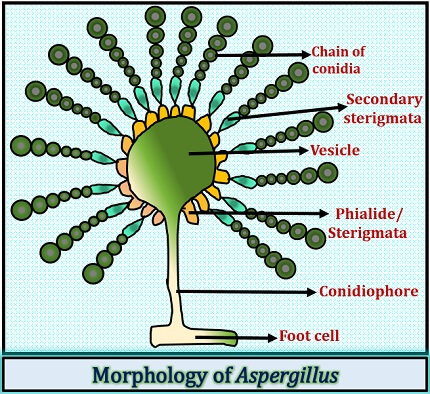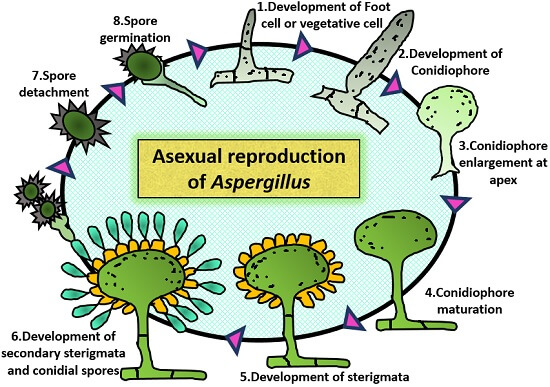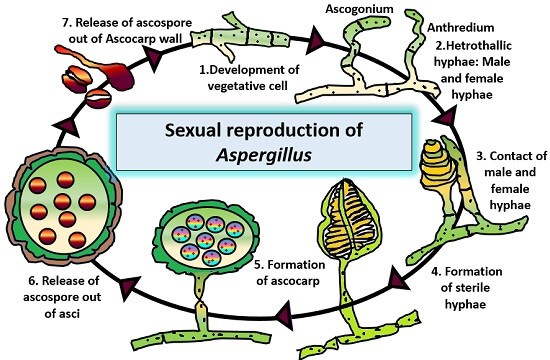Aspergillus is a common fungus, which is present everywhere (in the soil, air, water etc.), or we can say it is present in a wide range of conditions. Therefore, these are ubiquitous in nature. It consists of several 100-500 species, among which some are economically important, and some are deleterious, i.e. pathogenic. It was named in 1729, by a scientist named Antonio Micheli who was the director of the public gardens in Florence.
Classification :
- Kingdom: Fungi
- Division: Ascomycota
- Class: Eurotiomycetes
- Order: Eurotiales
- Family: Trichocomaceae
- Genus: Aspergillus
Most predominantly, the Aspergillus species are found in the damp areas and decaying matter. Aspergillosis is the disease caused by the various pathogenic strains of Aspergillus. In this context, we will mainly study morphology, structural properties, life-cycle and the economic importance of the medically important fungus Aspergillus.
Content: Aspergillus
Structure of Aspergillus
Aspergillus has a filamentous structure. It consists of the following components in its cell structure that include:

Foot cell: It is the vegetative structure of the cell called the vegetative hyphae. It is found attached to the substratum, through which the hypha absorbs the nutrient for its further growth. Foot cell is generally L or T shaped. When it grows, it gives rise to the conidiophore.
Conidiophore: It is long, slender and perpendicular to the foot cell or vegetative hyphae. Conidiophore is the erect hyphal branch, which enlarges at an apex and gives rise to the vesicle.
Vesicle: It is rounded, elliptical or club-shaped, which develops a layer of cells called phialides.
Conidia: These are the exogenous reproductive structure evolving from the sterigmata. The conidia appear in chains and are having a basipetal arrangement, in which the youngest conidia present at its base and the oldest conidia at the top.
Mycelium: It is hyaline, septate, branched, multicellular, multinucleated and tubular in structure. Mycelium is encased by the two layers, namely inner layer (made of cellulose) and an outer layer (made of chitin).
Cytoplasm: It is granular in appearance consisting of cytoplasmic bodies such as mitochondria, endoplasmic reticulum, ribosomes, vacuoles etc.
Features
- Aspergillus also called black or green mould, because the majority of them form black and green spores on the substratum and give a mouldy appearance.
- The species of Aspergillus are also called sac fungi because their sexual spores are produced within the sacs called Asci.
- The mode of nutrition is heterotrophic, which means they depend upon others for food and nutrition.
- Aspergillus are common moulds which are widespread and ubiquitous in nature.
- These can tolerate extreme environmental conditions like high temperature.
- Most of the Aspergillus species reproduce asexually through conidiospores, and few grow sexually through ascospores.
- Aspergillus species are Terricolous, i.e. most of the species grow on the ground or soil.
- The spores of Aspergillus are abundant in nature and can be saprophytic and parasitic.
- Chlorophyll is absent in this, i.e. these can not prepare their own food.
- Aspergillus obtains nutrition from the environment through vegetative hyphae, which then grows to produce reproductive structure, i.e. spores.
- The hyphae of the Aspergillus species are of two types:
-
- Vegetative hyphae: It helps in nutrient absorption.
- Reproductive hyphae: It helps in the production of fungal spores.
-
Reproduction of Aspergillus
The Aspergillus reproduces by the following three methods:
- Vegetative
- Asexual
- Sexual
Vegetative Reproduction
Vegetative reproduction occurs by the fragmentation method, in which a vegetative hypha breaks into few fragments which then develops into a new vegetative body.
Asexual Reproduction
The asexual reproduction of Aspergillus includes the following steps:

- Firstly, the foot cell develops a small outgrowth by absorbing nutrients from the substratum.
- Then, the foot cell gives rise to the long and slender hyphae called conidiophore.
- After that, the conidiophore grows and enlarges at the apex by the nuclear division to form a vesicle.
- The vesicle then grows and undergoes mitotic nuclear divisions to form sterigmata.
- Sterigmata are uninucleate, which also undergoes mitotic division and transfers one nucleus to the secondary sterigmata.
- These secondary sterigmata then form a chain of conidia in a basipetal arrangement.
- After that, conidiospores gets detached from the hyphae either accidentally or through certain environmental factors and remains in the soil at dormant state.
- When the spores get favourable conditions, they form a germ tube or undergo germination to form new vegetative hyphae.
Sexual Reproduction
The sexual reproduction rarely occurs only in the heterothallic species those contain both male and female hyphae. A.heterothallic is an example of the species that undergo sexual reproduction. The heterothallic hyphae consist of female hyphae called Ascogonium and the male hyphae called Anthredium.
Ascogonium possesses three parts (Basal, middle and apical) and it is multinucleate, septate and loosely coiled. Anthredium possesses two parts (Upper and lower), and it is unicellular, multinucleate and septate. The sexual reproduction of Aspergillus involves the following steps:

- First, the female and the male hyphae contacts with each other.
- After that fusion occurs between the female and male hyphae, after which the antheridium contents go inside the ascogonium through the point of junction, Plasmogamy occurs in the ascogonium, after which a cytoplasmic division takes place.
- After Plasmogamy, the ascogonium develops into the fruiting body called Ascocarp, where the karyogamy occurs. Then, 8 ascospores form inside the Asci (saclike structure), which are generally pear-shaped.
- After the maturation of ascocarp, a protective layer (peridium) eventually forms.
- Then by the maturation of the asci, the ascospores release out by the lysis of asci and then through the ascocarp wall.
- The ascospores remain dormant in the environment and are unicellular, wheel-shaped and 5µm in diameter. Its wall differentiates into three layers, namely an outer layer (thick), a middle layer or epispore and an inner layer (thin).
- On favourable conditions, they germinate new vegetative hyphae by the formation of a germ tube.
Economic Importance
Positive Impacts
- A.nidulans is extensively used as the model organisms for the study of the parasexual cycle, regulation of metabolic pathway, cell cycle, hyphal polarity etc. in the filamentous fungi.
- Helps in the bioassay of soil for tracing out of the elements like copper and arsenic by A.niger and A.virens, respectively.
- Aspergillus species are capable of low-rank coal solubilization.
- Useful in the production of organic acid like gluconic acid, citric acid etc. by A.niger, A.fumaricvus, respectively.
- It releases enzymes that play an important role in the decomposition of organic matter.
- Useful in the production of antibiotics like Proliferin, Fumigalin, Aspergillin etc by A.proliferans, A. fumigatus and A.niger, respectively.
- Aspergillus helps in nutrient recycling, where they breakdown the complex polymeric compounds into simpler ones by secreting some enzymes and metabolites which are further absorbed by the hyphae.
- A.oryzae helps in the production of sake wine by fermenting rice.
- Useful in the production of amylase by A.niger and A.oryzae.
Negative Impacts
- Some species of Aspergillus are pathogenic. For instance, A.fumigatus is an opportunistic fungus that can cause a fatal disease “Aspergillosis” in humans.
- In animals (particularly chickens species), Aspergillus species cause brooder disease (pneumonia of lungs).
- It produces secondary metabolites that are harmful to human life.
- Some of the strains like A. flavus, A. paraciticus, A.niger etc. produce carcinogenic mycotoxins like aflatoxin and ochratoxin.
- Several species of Aspergillus contaminate the food products including fruits, vegetables, grains etc. by the production of their toxic metabolites.
- In plants, it causes fruit rot in many fruits like mango, date, pomegranate etc.
- Aspergillus is also called weed or contaminant of the laboratory, which can contaminate the biological culture like bacterial and fungal culture.
Therefore, there are both advantages and disadvantages of the Aspergillus that can cause a huge ecological impact by imposing positive and negative effects.
Thanks for the post. Very didactic!
Great post! From which source do you have the figures and diagrams?
Good information for school assignment MYCOLOGY MODULE, THANKS!
Very easy to understand, and I recalled my college days and teachers.